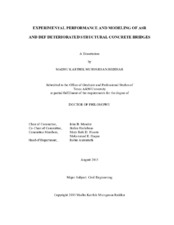| dc.contributor.advisor | Mander, John B | |
| dc.contributor.advisor | Hurlebaus, Stefan | |
| dc.creator | Murugesan Reddiar, Madhu | |
| dc.date.accessioned | 2015-10-29T18:50:30Z | |
| dc.date.available | 2017-08-01T05:37:35Z | |
| dc.date.created | 2015-08 | |
| dc.date.issued | 2015-06-24 | |
| dc.date.submitted | August 2015 | |
| dc.identifier.uri | https://hdl.handle.net/1969.1/155382 | |
| dc.description.abstract | Severe concrete cracking and ensuing deterioration caused by ASR/DEF expansion strains in bridge piers is a major concern for state transportation officials. A dual experimental and analytical modeling approach is used to determine the effects of severe ASR/DEF deterioration on concrete structures. A minimalist semi-empirical method is developed and validated to estimate ASR/DEF induced expansion strains in reinforced concrete structures. As part of the experimental study, expansion data are gathered from a large-scale C-beam specimen that is field conditioned for five years. The expansion model is then used to simulate the progression of ASR/DEF induced expansion strains in the C-beam specimens showing various degrees of deterioration. Considering the variability of the field recorded expansion data, the ASR/DEF expansion model simulates the expansion strains quite well. The severely damaged C-beam specimen is experimentally tested, and its overall and internal behavior are compared to previously tested C-beam specimens without and with ASR/DEF deterioration. Key improvements are made to the Compatibility Strut-and-Tie Method (C-STM) to better model the overall behavior of structures through failure. To incorporate the effects of ASR/DEF deterioration in the C-STM technique, cover and core concrete properties are modified. The expansion strains from the ASR/DEF model are inferred to estimate the prestressing forces to be applied to the C-STM to simulate the self-prestressing effects caused by the restraint offered by reinforcing steel to concrete core expansion. Although the appearance of the C-beam specimen was in poor condition, the experimental test did not show any reduction in the load carrying capacity of the structure, but compared to an undamaged benchmark specimen an overall increase in stiffness and decrease in ductility is evident. However, excessive cracking can cause accelerated hidden reinforcement corrosion which can be a cause of major concern, and in conjunction with ASR/DEF may affect the strength, stiffness and ductility of the structure. The displacement-based C-STM technique simulates the overall force-deformation and internal behavior of the concrete specimens without and with ASR/DEF deterioration well. | en |
| dc.format.mimetype | application/pdf | |
| dc.language.iso | en | |
| dc.subject | Alkali Silica Reaction | en |
| dc.subject | Delayed Ettringite Formation | en |
| dc.subject | ASR/DEF Deterioration | en |
| dc.subject | Compatibility Strut-and-Tie Modeling | en |
| dc.subject | Force-deformation modeling | en |
| dc.subject | Reinforced Concrete | en |
| dc.title | Experimental Performance and Modeling of ASR and DEF Deteriorated Structural Concrete Bridges | en |
| dc.type | Thesis | en |
| thesis.degree.department | Civil Engineering | en |
| thesis.degree.discipline | Civil Engineering | en |
| thesis.degree.grantor | Texas A & M University | en |
| thesis.degree.name | Doctor of Philosophy | en |
| thesis.degree.level | Doctoral | en |
| dc.contributor.committeeMember | Hueste, Mary Beth D | |
| dc.contributor.committeeMember | Haque, Mohammed E | |
| dc.type.material | text | en |
| dc.date.updated | 2015-10-29T18:50:30Z | |
| local.embargo.terms | 2017-08-01 | |
| local.etdauthor.orcid | 0000-0002-8169-3536 | |


